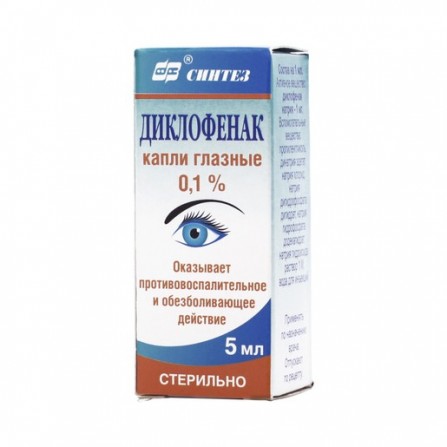Diclofenac-chrompharm eye drops 0.1% 5ml
Condition: New product
1000 Items
Rating:
Be the first to write a review!

More info
Active ingredients
Diclofenac
Release form
Drops
Composition
At 1 ml. Of the 1 M solution of sodium hydroxide (sodium hydroxide) to pH 6.5-7.5, water for injection to 1 ml.
Pharmacological effect
NSAIDs for topical use in ophthalmology, a derivative of phenylacetic acid. It has an anti-inflammatory and analgesic effect. Inhibiting COX-1 and COX-2 indiscriminately, disrupts the metabolism of arachidonic acid, reduces the amount of prostaglandins in the inflammatory focus. When applied topically, it reduces swelling and pain in inflammatory processes of non-infectious etiology.
Pharmacokinetics
The time to reach Cmax in the cornea and conjunctiva is 30 minutes after installation; penetrates the anterior chamber of the eye. In the systemic circulation in therapeutically significant concentrations does not penetrate.
Indications
Inhibition of miosis during cataract surgery. Inflammatory processes after surgical interventions. Prevention of cytoid edema of the optic nerve before and after surgery associated with removal and implantation of the crystalline lens. Inflammatory processes of non-infectious nature involving the anterior eye sections. apple. Pain syndrome during an excimer laser intervention.
Contraindications
Hypersensitivity to nonsteroidal anti-inflammatory drugs and other components of the drug. The third trimester of pregnancy. The child's age (up to 2 years).
Precautionary measures
It is not allowed to wear soft contact lenses simultaneously with the introduction of the drug. Solid contact lenses should be removed before instillation and re-installed only 20 minutes after the drug was injected. Effect on the ability to drive vehicles and work with mechanisms: Immediately after instillation, visual perception may become blurred, which can make it difficult to control the transport (t. hcar), work at heights. It is necessary to resume such activities only 15 minutes after the injection.
Use during pregnancy and lactation
Contraindicated in the III trimester of pregnancy. Use with caution during lactation.
Dosage and administration
Locally. Impale into the conjunctival sac before the operation 1 drop 5 times for 3 hours with an interval of 20-25 minutes. Immediately after the operation - 1 drop 3 times; then 1 drop 3-5 times a day for the required time. Other indications -1 drop 4-5 times a day.
Side effects
Eye burning. Vagueness of visual perception (immediately after instillation). Corneal obstruction (cont. Zyp); zyp; zyp; zyp; zyp; zyp; zyp; zyp; zyp; zyr. and vomiting.
Overdose
When using Diclofenac eye drops in recommended doses, overdose is unlikely.
Interaction with other drugs
Simultaneous use of Diclofenac with diflunisal (possible development of bleeding from the gastrointestinal tract) and other NSAIDs (including acetylsalicylic acid in high doses (≥3 g / day), sulfonylurea drugs, methotrexate is not recommended. to enhance their effect. If necessary, Diclofenac can be used simultaneously with other eye drops, including containing GKS. At the same time, the interval between applications should be at least 5 minutes to prevent the leaching of the active substances with subsequent doses.
special instructions
The drug is intended for topical use only and should not be injected subconjunctivally or into the anterior chamber of the eye. Before use, shake the bottle. For patients using contact lenses, instill the drug 5 min after their removal. The break between using different eye drops should be 5 min. Diclofenac's anti-inflammatory effect may mask the symptoms of infections. In the presence of infection or the threat of its development, simultaneously with the use of Diclofenac, local antibacterial treatment is prescribed. It is recommended to use caution when using the drug: - during ophthalmologic surgical interventions (prolonged bleeding time is possible,therefore, caution is recommended in patients with hemorrhagic diathesis or receiving anticoagulants) - patients with bronchial asthma combined with rhinitis or chronic sinusitis, since the risk of allergic reactions is increased when using acetylsalicylic acid or NSAIDs. The use of the drug in such patients can cause bronchospasm. Effect on the ability to drive vehicles and control mechanisms. During the period of drug treatment, care must be taken when driving vehicles and engaging in other potentially hazardous activities that require increased concentration and psychomotor reactions.




